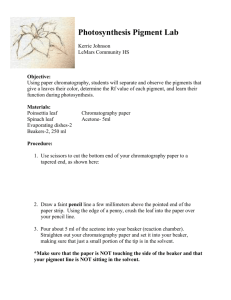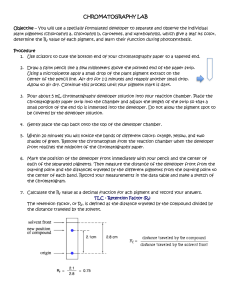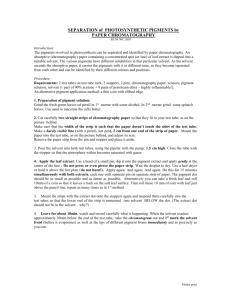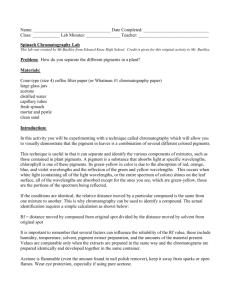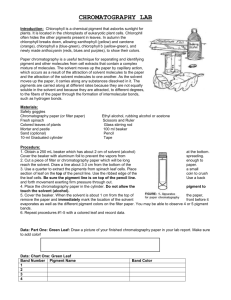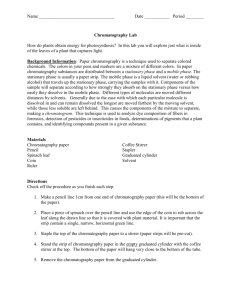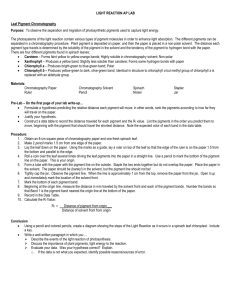Name Period ______ Date
advertisement
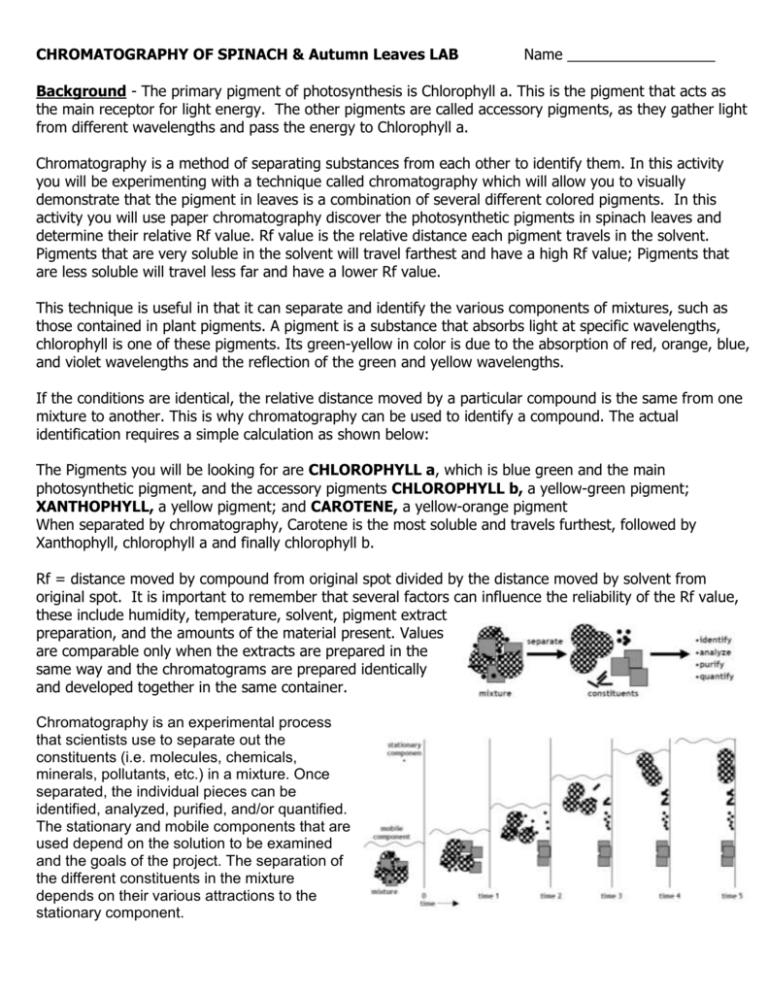
CHROMATOGRAPHY OF SPINACH & Autumn Leaves LAB Name __________________ Background - The primary pigment of photosynthesis is Chlorophyll a. This is the pigment that acts as the main receptor for light energy. The other pigments are called accessory pigments, as they gather light from different wavelengths and pass the energy to Chlorophyll a. Chromatography is a method of separating substances from each other to identify them. In this activity you will be experimenting with a technique called chromatography which will allow you to visually demonstrate that the pigment in leaves is a combination of several different colored pigments. In this activity you will use paper chromatography discover the photosynthetic pigments in spinach leaves and determine their relative Rf value. Rf value is the relative distance each pigment travels in the solvent. Pigments that are very soluble in the solvent will travel farthest and have a high Rf value; Pigments that are less soluble will travel less far and have a lower Rf value. This technique is useful in that it can separate and identify the various components of mixtures, such as those contained in plant pigments. A pigment is a substance that absorbs light at specific wavelengths, chlorophyll is one of these pigments. Its green-yellow in color is due to the absorption of red, orange, blue, and violet wavelengths and the reflection of the green and yellow wavelengths. If the conditions are identical, the relative distance moved by a particular compound is the same from one mixture to another. This is why chromatography can be used to identify a compound. The actual identification requires a simple calculation as shown below: The Pigments you will be looking for are CHLOROPHYLL a, which is blue green and the main photosynthetic pigment, and the accessory pigments CHLOROPHYLL b, a yellow-green pigment; XANTHOPHYLL, a yellow pigment; and CAROTENE, a yellow-orange pigment When separated by chromatography, Carotene is the most soluble and travels furthest, followed by Xanthophyll, chlorophyll a and finally chlorophyll b. Rf = distance moved by compound from original spot divided by the distance moved by solvent from original spot. It is important to remember that several factors can influence the reliability of the Rf value, these include humidity, temperature, solvent, pigment extract preparation, and the amounts of the material present. Values are comparable only when the extracts are prepared in the same way and the chromatograms are prepared identically and developed together in the same container. Chromatography is an experimental process that scientists use to separate out the constituents (i.e. molecules, chemicals, minerals, pollutants, etc.) in a mixture. Once separated, the individual pieces can be identified, analyzed, purified, and/or quantified. The stationary and mobile components that are used depend on the solution to be examined and the goals of the project. The separation of the different constituents in the mixture depends on their various attractions to the stationary component. Materials – Alcohol/Acetone (Use caution, do not breathe vapors) Spinach leaves Chromatography paper quarter Scissors Pencil Metric ruler Flask stopper Procedure – Preparation of the Paper chromatography strip 1. Cut chromatography paper strip. Use scissors to cut off the two bottom corners of the strip. [See the diagram below] TRY TO MINIMIZE TOUCHING THE STRIP. IT MAY INTERFERE WITH THE CHROMATOGRAPHY. Hold strip by edges. 2. Measure 2 cm from the bottom of the paper strip. Lightly draw a pencil line across the strip. Do Not use ink 3. Place the leaf over the pencil line and Roll a quarter or other coin over the line Repeat until there is a very dark green line over the pencil line at least 15 times, Change leaf to different position each roll. 4. 5. 6. 7. 8. 9. 10. Place solvent in flask, only a small 1 cm high amount. Slowly lower the chromatography paper into flask. DO NOT allow pigment to touch solvent Cover with lid or stopper Let solvent rise until it reaches the mark at top of paper. KEEP WATCH! STOP just before solvent front reaches top Remove chromatogram and place on paper towel. Replace lid on solvent flask. DO NOT discard. Immediately draw a pencil line across the top of the strip where the solvent front got to before it dries. See diagram below. 11. Next draw a pencil line at the top of each pigment, showing how far that pigment traveled. 12. Measure the total distance traveled by solvent from the starting line to the top in mm. Record on first line of Data table. 13. Measure the distance each pigment traveled (migration distance) from origin in mm. Record on data table. 14. On Data sheet, draw each migration line on chromatogram copy, use ruler and place lines according to the measurements you recorded in table. 15. Label and attach your chromatogram paper, in the space provided. 16. Label the pigments on your diagram, as well as the loading line (start) and solvent front (finish) 17. Calculate the Rf value for each pigment. Record on Data Table. Rf value is the relative distance each pigment traveled. Rf = Distance Substances traveled Distances Solvent traveled Example: Solvent front traveled 6.0 cm Pigment 1 traveled 5.5 Rf pigment 1 = 5.5/6.0 = .92 Ex. 2 Rf Pigment 3 = 3.0/6.0 = .5 Spinach Leaf Autumn Leaf Calculate your Rf values Show your work: Data Table Chromatography of plant pigments Band Number Solvent Name of Pigment N/A Color of Pigment Migration distance (mm) Rf value 1.0 1 (top) 2 3 4 (bottom) 1. What reference numbers (Rf) did you calculate for chlorophyll a and b on your spinach strip? How do they compare to the values given The reference numbers (Rf) for the chlorophylls are: 0.28 = chlorophyll a 0.18 = chlorophyll b Use these values to figure out which chlorophyll you have. _______________________________________________________________________ _______________________________________________________________________ _______________________________________________________________________ 2. Which pigment is the MOST soluble in the solvent? Explain your answer. _______________________________________________________________________ _______________________________________________________________________ 3. Which pigment is LEAST soluble in the solvent? Explain your answer. _______________________________________________________________________ _______________________________________________________________________ 4. Which pigment band is the widest? Hypothesize why. _______________________________________________________________________ _______________________________________________________________________ 5. Which pigment band is the most intense (darkest)? Hypothesize why. _______________________________________________________________________ _______________________________________________________________________ 6. Which autumn leaf color is not present in the spinach? What pigment causes this color? _______________________________________________________________________ _______________________________________________________________________ 7. How could Rf values be useful when comparing chromatograms from other types of leaves? _______________________________________________________________________ _______________________________________________________________________ 8. If you could go back and redo this lab, what mistakes would you correct? If none, identify areas where someone could make an error. Explain. _______________________________________________________________________ _______________________________________________________________________ _______________________________________________________________________ _______________________________________________________________________ 9.What kind of professional out there would need to use a skill such as chromatography? (forensics? chemist? etc.) Why? _______________________________________________________________________ _______________________________________________________________________ _______________________________________________________________________ _______________________________________________________________________


